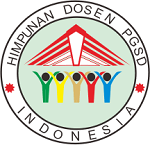PENGEMBANGAN MEDIA PEMBELAJARAN INTERAKTIF PADA MATA PELAJARAN MEKANIKA TEKNIK KELAS X DESAIN PERMODELAN SMK NEGERI 1 PADANG
DOI:
https://doi.org/10.24114/jgk.v4i4.19907Abstract
Abstract: Development of Interactive Learning Media in Class X Engineering Mechanics Subjects Modeling Design of SMK Negeri 1 Padang. The purpose of this research is to develop interactive learning media that are valid, practical, and effective. This research was conducted using a 4D development model. The research stage includes the definition stage, the design stage, the development stage, and the dissemination stage. The instrument used to measure the validity of the media was in the form of a questionnaire and to measure the practicality of the media in the form of direct observation sheets, while measuring the effectiveness of the media in the form of multiple-choice questions. This interactive learning media was made using Adobe Director 11. The results showed that interactive learning media were declared valid based on the criteria of each aspect by the validator. In the media expert validator aspect obtained an average value of 0.91 and the material validator aspect obtained an average value of 0.915. Interactive learning media is stated to be very practical based on student responses to aspects that have successfully obtained an average value of 84,219, for the time aspect it is obtained 85,513, for the attractiveness aspect the average value is 84,861. Interactive learning media is declared effective in terms of classical completeness value of 87.5%. Keywords: Interactive Learning Media, Mechanical Mechanics, 4D Development Model, Effectiveness, Validity, Practicality. Abstrak: Pengembangan Media Pembelajaran Interaktif Pada Mata Pelajaran Mekanika Teknik Kelas X Desain Permodelan SMK Negeri 1 Padang. Tujuan penelitian ini adalah untuk mengembangkan media pembelajaran interaktif yang valid, praktis dan efektif. Penelitian ini dilaksanakan menggunakan model pengembangan 4D. Tahap penelitian meliputi tahap pendefinisian, tahap perancangan, tahap pengembangan, dan tahap penyebaran. Instrumen yang digunakan untuk mengukur validitas media berupa angket dan untuk mengukur praktikalitas media berupa lembar observasi langsung, sedangkan untuk mengukur efektifitas media berupa soal pilihan ganda. Media pembelajaran interaktif ini dibuat dengan menggunakan Adobe Director 11. Hasil penelitian menunjukan bahwa media pembelajaran interaktif dinyatakan valid berdasarkan penilaian dari masing-masing aspek oleh validator. Pada aspek validator ahli media diperoleh nilai rata-rata sebesar 0,91 dan pada aspek validator materi diperoleh nilai rata-rata sebesar 0,915. Media pembelajaran interaktif dinyatakan sangat praktis berdasarkan respon siswa untuk aspek kemudahan diperoleh nilai rata-rata 84,219, untuk aspek waktu diperoleh 85,513, untuk aspek daya tarik diperoleh nilai rata-rata 84,861. Media pembelajaran interaktif dinyatakan efektif ditinjau dari nilai ketuntasan klasikal sebesar 87,5%. Kata Kunci: Media Pembelajaran Interaktif, Mekanika Teknik, Model Pengembangan 4D, Efektifitas, Validitas, Praktikalitas.Downloads
Published
2020-09-18
How to Cite
Fauzan, T., Abdullah, R., & kusumaningrum, I. (2020). PENGEMBANGAN MEDIA PEMBELAJARAN INTERAKTIF PADA MATA PELAJARAN MEKANIKA TEKNIK KELAS X DESAIN PERMODELAN SMK NEGERI 1 PADANG. JGK (Jurnal Guru Kita), 4(4), 1–9. https://doi.org/10.24114/jgk.v4i4.19907
Issue
Section
Articles
License
Authors published with the JGK (Jurnal Guru Kita) agree to the following terms:
- Authors retain copyright and grant the journal the right of first publication with the work simultaneously licensed under a Creative Commons Attribution License (CC BY-SA 4.0) that allows others to share the work with an acknowledgment of the work's authorship and initial publication in this journal.
- Authors are able to enter into separate, additional contractual arrangements for the non-exclusive distribution of the journal's published version of the work (e.g., post it to an institutional repository or publish it in a book), with an acknowledgment of its initial publication in this journal.
- Authors are permitted and encouraged to post their work online (e.g., in institutional repositories or on their website) prior to and during the submission process, as it can lead to productive exchanges, as well as earlier and greater citation of published work. (See The Effect of Open Access)




























